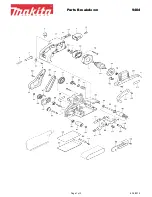
Safety
Version 1.0.1 - 2020-11-12
7
Translation of original instruction
GU35P
EN
GU35P
_GB
.f
m
CAUTION!
Dirty or contaminated personnel protective equipment can cause illness. It must be
cleaned after each use and at least once a week.
1.8
For your own safety during operation
WARNING!
Before switching on the polishing machine, make sure that it does not endanger
persons, that no objects are damaged, and that the direction of rotation of the polishing
wheels is correct.
Avoid any unsafe work methods:
The instructions mentioned in these operating instructions have to be strictly observed dur-
ing assembly, operation, maintenance and repair.
Use protective glasses!
Do not work on the polishing machine, if your concentration is reduced, for example,
because you are taking medication.
Stay on the polishing machine until the polishing machine has come to a complete stand-
still.
Use the specified personal protective equipment. Ensure you wear close-fitting clothing
and, if necessary, a hairnet.
Make sure that your operation does not create a safety hazard.
1.9
Emissions
The generation of noise emitted by the polishing machine is 70 to 75 dB(A). The sound power
level is 78 to 83 dB(A). If the polishing machine is installed in an area where various machines
are in operation, the noise exposure (immission) on the operator of the polishing machine at the
working place may exceed 80 dB(A).
INFORMATION
This numerical value was measured on a new machine under the operating conditions specified
by the manufacturer. The noise behaviour of the machine might change depending on the age
and wear of the machine.
Furthermore, the noise emission also depends on production engineering factors, e.g. speed,
material and clamping conditions.
INFORMATION
The specified numerical value represents the emission level and does not necessarily a safe
working level. Though there is a dependency between the degree of the noise emission and the
degree of the noise disturbance it is not possible to use it reliably to determine if further precau-
tion measures are required or not. The following factors influence the actual degree of the noise
exposure of the operator:
Characteristics of the working area, e.g. size or damping behaviour,
other noise sources, e.g. the number of machines,
other processes taking place in proximity and the period of time, during which the operator
is exposed to the noise.
Furthermore, it is possible that the admissible exposure level might be different from country to
country due to national regulations. This information about the noise emission should, how-
ever, allow the operator of the machine to more easily evaluate the hazards and risks.




































